How to choose the most suitable type of heating batteries for an apartment from all the variety of options?
You are viewing the section Radiators, located in the large section Heating.
Subsections: Service, Installation, Types.
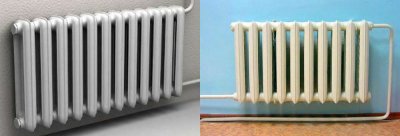
Heating efficiency depends largely on heating radiators.
There are a huge number of them on the market various options, differing from each other in design, materials of manufacture, installation method and heat transfer.
What types of heating radiators are there?
Batteries are made from various materials:
- cast iron;
- steel;
- aluminum;
- copper;
- bimetal.
Cast iron

Cast iron radiators are made up of several sections connected to each other. pipesThe pipes are hermetically welded together and with the sections.
Such heaters are installed under window openings. The size and number of radiator sections are selected depending on the volume of the room and the location of the apartment: corner or central.
Cast iron radiators can withstand pressure at 18 atmospheres. The maximum temperature of the coolant must not exceed 150 °CThe power of cast iron heaters is 100-150 W.
The advantages of such a heating device include:
- good heat accumulation;
- wear resistance;
- strength;
- absence blockages;
- long term exploitation;
- compatibility with other materials;
- resistance to low quality of the coolant.
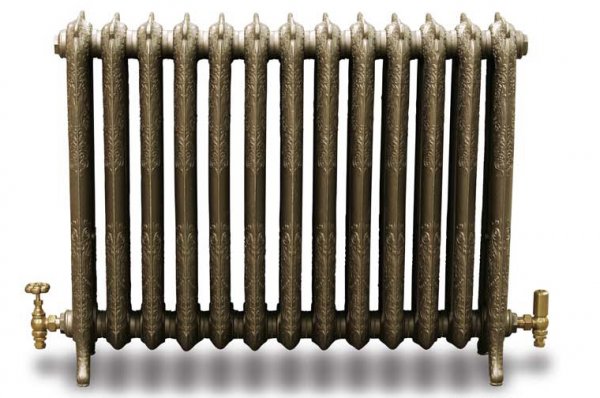
Photo 1. Cast iron radiator Rococo in retro style, maximum coolant temperature - 110° C, manufacturer - Carron, England.
Flaws:
- big weight, which makes installation and transportation of the battery difficult;
- necessity additional decoration due to unpresentable appearance;
- high fuel costs;
- difficulty in cleaning due to design features.
Aluminum
Aluminum radiators are distinguished by their pleasing appearance. They heat the room in two ways - with the help of heat transfer and convectionAluminum heat exchangers are manufactured in two ways: by casting and by extrusion.
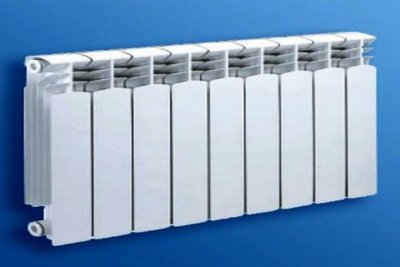
Casting method consists in the fact that under increased pressure, recesses-sections are created in the aluminum sheet.
Two sheets with sections then hermetically fastened together. The number of sections can vary. In addition, it is possible to attach additional ones.
Second method suggests extruder manufacturing vertical elements that are connected on a horizontal manifold. This manufacturing method eliminates the possibility of adding additional sections.
The working pressure of aluminum radiators is from 5 to 16 atmospheres. They are able to withstand temperatures without deformation. no more than 110 °C. Aluminum is very sensitive to the presence of foreign impurities and even the smallest contaminants in the coolant.
pH the coolant must be 7-8. The capacity of one battery, depending on the design features, is 81—212 W.
Advantages:
- high thermal conductivity;
- light weight, ensuring ease of installation;
- nice appearance, suitable for any interior;
- fast heating;
- Possibility of upgrading by adding thermostats and thermal valves.
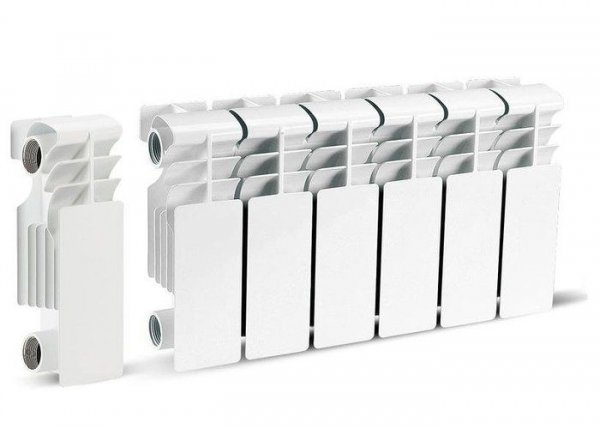 ?
?
Photo 2. Aluminum radiator Eco 200 wall-mounted, sectional, manufacturer - "Lammin", China.
Flaws:
- sensitivity to physical impacts, even a low-quality coolant can cause irreparable damage to an aluminum heating device;
- necessity installation of a device for releasing air;
- opportunity leaks between sections;
- incompatibility with pipes made of other materials.
Steel
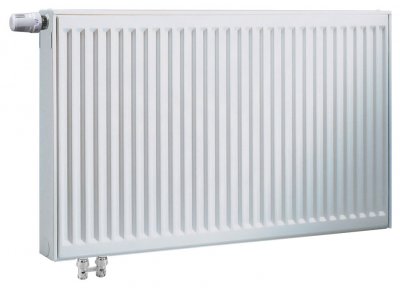
Steel batteries have an attractive appearance. They come in both standard and original designs.
The working pressure of steel radiators is from 6 to 15 atmospheres. Thickness of heat exchanger walls should not be less than 1.15 mm.
?Steel batteries can withstand temperatures up to 120 °C. The heater power can reach 1800 W.
Steel radiators are connected to the heating system in two ways: side or bottom. The latter is universal, but its cost is higher.
Depending on the number of sections, there are several types of steel radiators:
- Type 10 has one row of panels without convector.
- Type 11 - one row of panels, one convector, without a grid at the top.
- Type 20 - two rows of panels, does not have a convector but has a grill that releases warm air.
- Type 21 - two rows of panels and convection fins in a closed casing.
- Type 22 - two panels, two convectors and a casing.
- Type 30 - Three-row heat exchanger, but without the presence of convection fins with an air duct grille.
- Type 33 - three panels, three convectors in a closed casing.
Advantages:
- fast heating;
- heating of the room in two ways - convection and radiation;
- long term exploitation;
- light weight;
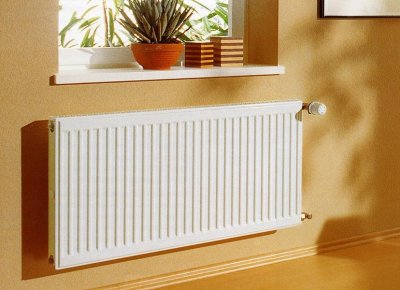
- low price;
- attractive appearance;
- compatibility with other materials;
- economy;
- simplicity service;
- Possibility of upgrading by installation thermostat.
Flaws:
- low resistance to corrosion;
- inability to endure pressure drops in the heating system;
- If you leave it without water for a long time, the steel will start to rust.
Bimetallic
Bimetallic heaters have an aluminum body and steel pipes inside. They are most common when installed in residential premises.
The working pressure can reach 40 atmospheres. The capacity of the bimetallic heat exchanger is 180 W. Bimetallic batteries can withstand temperatures up to 130 °C. Maximum service life of the radiator 20 years old. Bimetallic heaters are divided into several types:

- 100% bimetallic, consist of a steel core and an aluminum coating.
- 50% bimetallic have steel vertical pipes, the rest is made of aluminum.
Advantages:
- long service life;
- light weight;
- strength;
- ability to withstand water hammer;
- resistance to mechanical impacts;
- resistance to corrosion;
- pleasant appearance.
The only disadvantages of such radiators are their high cost.
Important! Bimetallic radiators, like steel ones, you can't leave it without water for a long time, since it is in the steel pipes that the coolant is located.
Copper
Copper heat exchangers are original elements. They consist of pipes with a working liquid circulating inside and special finned plates. The working pressure of copper radiators is 16 atmospheres.
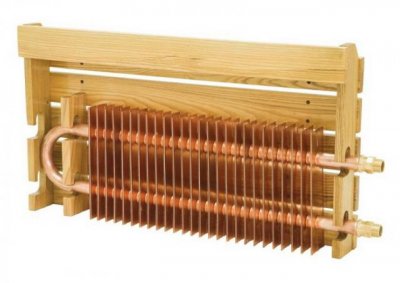
The maximum temperature of the coolant must not exceed 150 °C.
Advantages:
- high heat transfer;
- light weight;
- long service life;
- resistance to temperature and pressure changes;
- economy.
Attention! Copper radiators are recommended to be installed in a heating system where the coolant contains a large amount chlorine salts.
Essential disadvantages copper radiators do not have. The largest of them is high cost.
Types of battery designs
According to design, heat exchangers are:
- sectional;
- panel;
- tubular;
- lamellar.
Sectional radiators
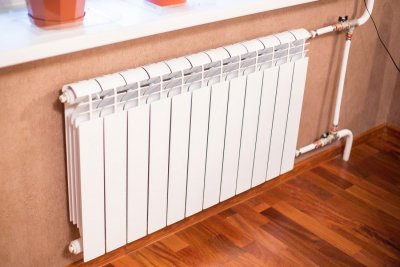
Sectional heat exchangers consist of from one or more sections, hermetically connected to each other. Inside each section there are channels through which the coolant circulates.
The advantages of such batteries include the ability adding additional sections.
The radiator heats the room in two ways: heat transfer and convection, which ensures rapid heating of the air. The cost of sectional radiators is low.
Panel
Panel heat exchangers are interconnected metal sheetsEach sheet has notches pressed into it on the inside. When connecting two sheets we get unique sections, through which the coolant circulates.
The advantages of panel radiators are the variety of models, which allows you to select the design of the heating device in accordance with the interior. Panel heaters have small size, so they can be installed in any place, even hard to reach ones.
Tubular

Such heat exchangers consist of several tubes welded to the manifold.
The design features ensure uninterrupted circulation of the coolant.
The advantages of such a heater include resistance to water hammerSuch batteries are compact and have an original appearance.
Plate radiators are a curved tube with vertical plates welded to it. They heat the room by convection and radiation. A striking example of a plate radiator is copper.
Useful video
Check out this video that explains the advantages and disadvantages of different types of radiators.
Battery for apartment
Not every heat exchanger described above can be installed in an apartment. multi-storey buildings, especially of old construction, are possible pressure drops. Therefore, you should choose a battery that can withstand sudden pressure changes.
For an apartment the aluminum heater is also not suitable, since the quality of the coolant in the pipes is quite low.
































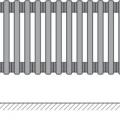
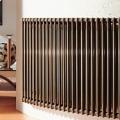
Comments